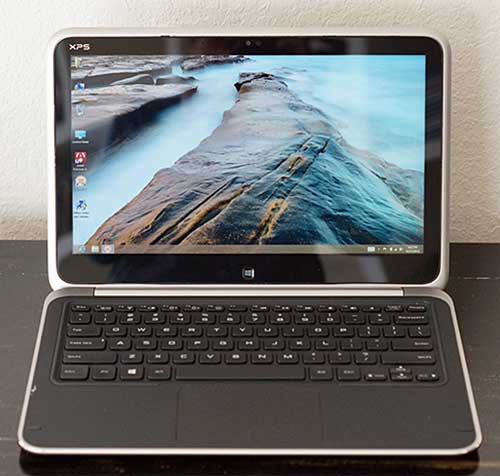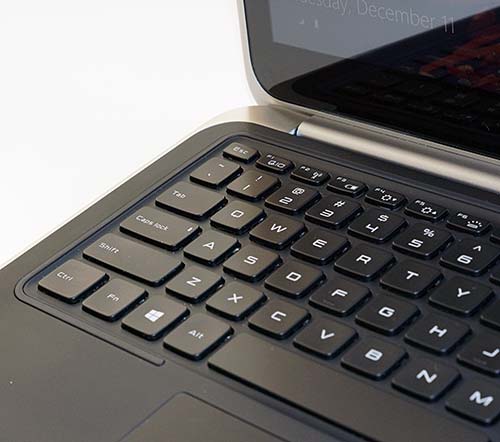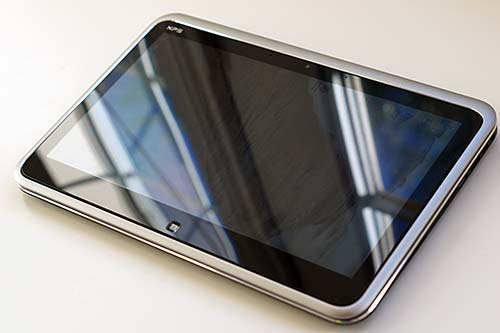Dell XPS 12
07:30
The Dell XPS 12 joins the short list of Windows 8
convertible tablet-Ultrabooks to hit the market after that new OS
launched in late October. The XPS 12 started shipping in December 2012,
and it has everything you love about the XPS line mated to the older
Dell Duo's easel-mounted touchscreen. The build is extremely solid,
upscale and attractive with Dell's signature carbon fiber surfaces (top
and bottom this time), an aluminum frame and soft-touch painted
magnesium wrist rest. Unlike the Dell Inspiron Duo, this isn't a
plasticky netbook with a touchscreen, but a premium ultraportable that
starts at $1,199. It features third generation Intel Core i5 and i7 ULV
CPUs, 4 to 8 gigs of RAM and fast SSD drives. The XPS 12 runs both the
Modern UI with Live Tiles and the traditional desktop with support for
Windows 7 programs (x86, .exe apps).
Other goodies include an excellent
island style backlit keyboard that's every bit as wonderful to use as
the XPS 13's, a 1.3MP webcam, dual band Intel Centrino Advanced-N 6235
WiFi (compatible with WiDi) and Bluetooth 3.0.
Full HD Display
 The XPS 12 has a lovely 12.5" full HD
IPS touchscreen with 400 nits brightness and Gorilla Glass. It has wide
viewing angles, extremely sharp text and pleasing colors. 1920 x 1080
means 1080p videos play without scaling and photos look very detailed.
Windows 8's new Live Tile interface scales perfectly on high res
displays, keeping everything the same readable and touchable size as
they'd be on 720p displays, but the desktop UI (the other half of
Windows 8 that looks much like Windows 7) still suffers from shrunken
touch targets and text. You can scale fonts on the Windows desktop side
of things, and Dell wisely ships it set to 125% zoom, as does Sony with
their Vaio Duo 11 that runs full HD on an even smaller 11.6" display.
The XPS 12 has a lovely 12.5" full HD
IPS touchscreen with 400 nits brightness and Gorilla Glass. It has wide
viewing angles, extremely sharp text and pleasing colors. 1920 x 1080
means 1080p videos play without scaling and photos look very detailed.
Windows 8's new Live Tile interface scales perfectly on high res
displays, keeping everything the same readable and touchable size as
they'd be on 720p displays, but the desktop UI (the other half of
Windows 8 that looks much like Windows 7) still suffers from shrunken
touch targets and text. You can scale fonts on the Windows desktop side
of things, and Dell wisely ships it set to 125% zoom, as does Sony with
their Vaio Duo 11 that runs full HD on an even smaller 11.6" display.
Design and Ergonomics
The laptop weighs 3.35 pounds, which is
heavier than the 2.89 lb. Vaio Duo 11 but a little lighter than both the
Lenovo IdeaPad Yoga 13 and 12.5" Lenovo ThinkPad Twist convertibles.
It's easy to hold and grip thanks to the carbon fiber finish and is fine
for use on a table or lap. At twice the weight of the iPad and Android
10" tablets, you won't be holding it in your hands for an hour of
reading unless you're a body builder.
The styling and looks are pure XPS, and
that's a good thing. We really like the XPS line's attention to detail,
good build quality and high quality materials. It feels rugged and
strong without looking bulky or ungainly. Quite the opposite, it looks
slim and sleek with modern lines.
The tablet has two USB 3.0 ports, a mini
DisplayPort (more versatile than HDMI since you can use adapters for
VGA, HDMI and DisplayPort for ultra-high resolution monitors) and a
3.5mm combo audio jack. Like the XPS 13, there's no SD card slot. The
tablet's power button is on the side, as is the display rotation lock
button and volume rocker so you can access these even when the tablet is
closed. There are multimedia controls including volume on the Fn row of
the keyboard as well.
The side mounted stereo speakers put out
clear sound that's lacking in bass, as you'd expect from a small
computer. Volume was loud enough to fill a small room and was fine for
watching a feature length film on Netflix. There's a 3.5mm stereo jack
for higher quality audio output and/or private listening, and you can
use Bluetooth headphones and speakers as well.
The 1.3MP webcam yielded bright and
relatively detailed video in Skype and the built-in dual array mics did a
good job of picking up our voice.
Horsepower and Performance
Third generation Intel Ivy Bridge Core
i5 and i7 ULV CPUs power the machine, with Intel HD 4000 graphics. In
other words, it's a standard Ultrabook. The base model has the usual
1.7GHz Intel Core i5-3317U, 4 gigs of DDR3 1600MHz RAM and a 128 gig
Samsung PM830 SSD drive. For a pricey $1,699 you can get it with the
1.9GHz Intel Core i7-3517U ULV CPU, 8 gigs of RAM and a 256 gig SSD. You
can also order it in a variety of in-between configurations, like the
tempting $1,499 Core i5 with a 256 gig SSD and 8 gigs of RAM. While the
performance gain of the Core i7 isn't huge, many of us will be tempted
by more storage space. The 4 gig model uses single channel RAM and the 8
gig uses a dual channel configuration for a slight speed boost.
The XPS 12's performance is in line with
other Windows Ultrabooks running on the same hardware. Our Core 1.7GHz
i5 unit with 4 gigs of RAM performed similarly to the Asus Taichi 21, Asus Zenbook Prime UX31A and Sony Vaio Duo 11.
The machine feels responsive and is more than adequate for Office, web,
streaming video, photo editing and light video editing. It has the
power to be a main machine unless you do a lot of heavy lifting with
computationally intensive applications or lots of HD video editing.
Clearly, with Intel HD 4000 graphics, this isn't a gaming rig, though it
can play older games and casual games perfectly well.
Dell Ultrabooks tend to be a little
noisier than other Ultrabooks, as are some Lenovo machines. Dell builds
corporate products that are built to last years, and we suspect their
cooling errs on the side of longevity. That said, the CPU runs in the
40's Centigrade, which isn't unusually cool. Fan noise isn't bad at all
when the XPS 12 is unplugged, but when plugged into power you'll hear
the fan more often at moderate volume. Thanks to the carbon fiber
casing, the laptop doesn't get too hot to touch, even when working
moderately hard.
Keyboard and Trackpad

Like the XPS 13, the XPS 12 has a superb
island style keyboard that's a joy for those of us who spend a lot of
time writing. The sculpted keys keep your fingers located and there's
good key separation along with better than average travel for a thin
machine. The white backlighting is effective and it has three levels
(off, medium and bright). The XPS and Lenovo IdeaPad Yoga have the best keyboards in the convertible Ultrabook space.
The keyboard has a standard layout with
the expected oversized keys for both shift keys, backspace, enter, caps
lock and the tab key. There's a small arrow pad and the Fn row up top
does double duty with multimedia and notebook control keys (you'll have
to hit the Fn key to use functions like volume and wireless control).
The Cypress trackpad is fairly large for
a 12.5" machine and gestures such as side swipes to bring up the
Charms menu and multi-tasking list worked fine, as did pinch zooming.
Given the touch screen, we suspect most folks will use touch rather than
the trackpad for Windows 8's grand gestures and zooming. Though the
trackpad visually blends into the wrist rest area, its texture is
smoother than the soft touch wrist rest area and the border is
physically distinct so your finger won't unwittingly wander off. The
trackpad uses the now standard buttonless design where the entire
trackpad moves down and up with an audible click when you left or right
click.
Battery Life
So far, Windows 8 convertible Ultrabooks
haven't had stellar battery life. That said, the Dell XPS 12 leads this
lackluster pack with 5 hours and 30 minutes of runtime on a charge with
average use at 50% brightness. In our test we edit MS Office documents
with Outlook running in the background, stream HD video for 45 minutes,
surf the web with 8 tabs open and play music for 30 minutes. The Dell
comes out ahead of the Vaio Duo 11 (not including the Vaio's optional
sheet battery) by 30 minutes and lasted a full two hours longer than the
Asus Taichi 21. It also outlasted the Lenovo IdeaPad Yoga 13 (which
admittedly drives a larger display) by 35 minutes.
The Dell has a relatively generous 47
WHr, 6 cell battery that's sealed inside and it comes with a compact
notebook style charger. There's a small button on the computer's right
side and 4 LEDs that indicate charge level.



0 comments